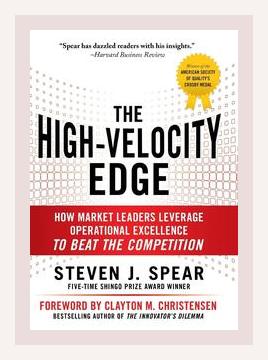Business StrategyStrategic Execution
The High-Velocity Edge: How Market Leaders Leverage Operational Excellence to Beat the Competition by Steven J. Spear is a comprehensive guide that explores how top-performing organizations achieve superior performance through operational excellence. The book delves into the principles and practices that make these companies consistently outperform their competitors. Here’s a thorough summary of the key points, supported by concrete examples and actionable recommendations.
Introduction
Steven J. Spear’s The High-Velocity Edge explores the fundamental principles that allow organizations to consistently outperform their competitors. The book is grounded in extensive research and real-world examples from various industries, showcasing how operational excellence becomes a strategic advantage.
Major Points and Examples
1. Creating a Learning Organization
Principle:
Organizations that foster a culture of continuous learning and improvement tend to excel. They encourage their employees to identify problems and solve them to improve processes.
Example:
Toyota’s famous production system is a prime example. Toyota encourages all employees to stop the production line if a defect is found, thereby addressing issues immediately and learning from mistakes.
Actionable Step:
– Implement a Kaizen approach: Encourage small, incremental changes and daily improvements by all employees. Provide platforms for employees to share their ideas and recognize their contributions to creating a learning-focused environment.
2. Identifying and Solving Problems Quickly
Principle:
High-performing organizations are adept at not just identifying problems but also solving them promptly and effectively.
Example:
Alcoa, under CEO Paul O’Neill, emphasized safety as a key operational metric. Whenever an accident occurred, the company mobilized to identify the root cause and implemented solutions swiftly to prevent recurrence.
Actionable Step:
– Institute rapid problem-solving teams: Form cross-functional teams dedicated to tackling issues as they arise. Equip these teams with tools and training to quickly diagnose and correct problems.
3. Harnessing the Power of Collaboration
Principle:
Collaboration across various departments and levels within an organization enables more effective problem-solving and process improvement.
Example:
The U.S. Navy’s nuclear submarine fleet adopted collaborative practices where engineers, maintenance crews, and operational staff engaged in frequent, structured communication to maintain high levels of readiness and performance.
Actionable Step:
– Develop cross-functional collaboration initiatives: Launch projects that require input and cooperation from multiple departments. Regularly scheduled “all-hands” meetings or inter-departmental workshops can improve cohesion and collaborative efficiency.
4. Developing Deep Expertise
Principle:
Expertise, especially within frontline workers, is essential for identifying inefficiencies and improving processes.
Example:
Toyota’s mastery of production hinges not only on systems but also on the deep expertise of its employees, who are skilled in identifying subtle process deviations and making adjustments in real-time.
Actionable Step:
– Invest in continuous training and education: Create robust training programs designed to deepen employees’ expertise in their specific roles. Encourage ongoing education and provide access to resources that facilitate skill enhancement.
5. Leadership’s Role in Operational Excellence
Principle:
Effective leadership is critical for fostering an environment that supports continuous improvement and operational excellence.
Example:
Intel’s Andy Grove fostered a culture of disciplined operations and strategic execution by setting clear expectations and holding the organization accountable to high standards.
Actionable Step:
– Develop transformational leadership programs: Train leaders to model behaviors that support operational excellence, such as seeking feedback, promoting transparency, and encouraging risk-taking in a controlled manner.
6. Integrating Systems and Processes
Principle:
A well-integrated system and process framework helps organizations coordinate actions and maintain alignment with strategic goals.
Example:
The aerospace company Pratt & Whitney integrated its design and manufacturing processes, ensuring that production was aligned closely with design specifications to reduce errors and improve efficiency.
Actionable Step:
– Map and align processes with strategic objectives: Regularly review and refine processes to ensure they support overarching strategic goals. Use process mapping techniques to identify and eliminate inefficiencies.
Detailed Examples and Actions
Case Study: Alcoa’s Safety-first Strategy
Overview:
Alcoa under Paul O’Neill is highlighted extensively in Spear’s book. By making safety the top priority, Alcoa drove broader operational excellence throughout the company.
Specific Actions:
– Make a bold commitment to an operational metric: Choose one critical operational metric, like safety, and make it a focal point. Communicate its importance clearly across the organization.
– Create a real-time reporting system: Implement systems that allow incidents to be reported and addressed immediately, ensuring transparent and swift responses to issues.
Naval Reactor Program
Overview:
The U.S. Navy’s approach to maintaining its nuclear reactor fleet emphasizes rigorous adherence to procedures and continuous learning.
Specific Actions:
– Standardize processes with room for feedback: Develop clear, standardized procedures but include mechanisms for feedback and adjustments based on ground-level input.
– Conduct regular drills and simulations: Regularly simulate different operational scenarios to ensure readiness and fine-tune response mechanisms.
Toyota Production System
Overview:
The Toyota Production System (TPS) is explored in-depth, particularly its focus on empowering workers to halt production to resolve issues.
Specific Actions:
– Enable front-line decision-making: Equip employees with the authority and tools to stop work processes when they detect problems. Empower them to initiate problem-solving protocols immediately.
– Implement visual management tools: Use visual boards and other tools to display real-time process data to enhance transparency and speed of action.
Conclusion
The High-Velocity Edge provides a compelling framework for operational excellence that can drive competitive advantage. By fostering a culture of continuous learning, rapid problem-solving, deep expertise, effective leadership, and integrated systems, organizations can achieve and maintain superior performance.
Action Plan Summary:
- Adopt Kaizen Practices: Encourage daily improvements from all employees.
- Form Problem-Solving Teams: Rapidly address problems with cross-functional groups.
- Promote Cross-Functional Collaboration: Regular inter-departmental projects and meetings.
- Invest in Employee Expertise: Robust training programs and continuous learning.
- Train Transformational Leaders: Leadership development focused on operational excellence.
- Align Systems with Strategy: Regularly review and streamline processes.
By incorporating these practices, companies can leverage operational excellence to stay ahead of the competition, as illustrated through the diverse and concrete examples provided in The High-Velocity Edge.
